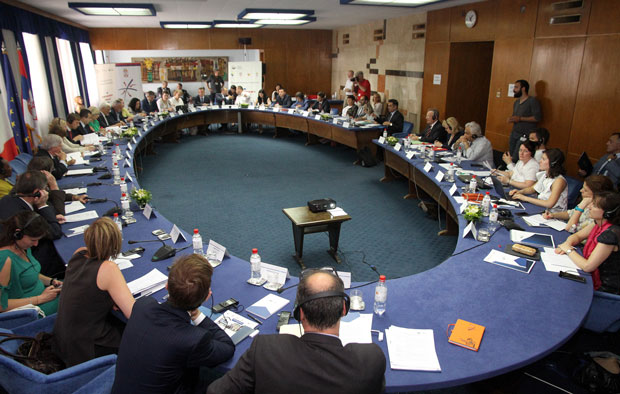Asylum and Migration

All in the same boat: The challenges of mixed migration
Climbing over razor wire fences, taking to sea in leaking boats or stowing away in airless containers, refugees and migrants around the world risk their lives every day in desperate attempts to find safety or a better life.
Behind the dramatic headlines and the striking images of people on the move, there are personal stories of courage, tragedy and compassion. Although refugees and migrants often use the same routes and modes of transport they have different protection needs.
To examine the challenges of protecting refugees in mixed migratory flows, the UN High Commissioner for Refugees organized a two-day regional conference on Refugee Protection and International Migration in Dakar, Senegal, in November 2008. This builds on the Dialogue on Protection Challenges launched by UNHCR in Geneva in December 2007.
Factors that have contributed to the increase in the scale of international migration include globalization and growing disparities in living conditions, both within and between countries. Among the people on the move today, many are seeking employment or educational opportunities, others want to reunite with family members and still more are fleeing persecution, conflict or blind violence in their countries.
While refugees and asylum seekers account for only a small proportion of the global movement of people, they frequently travel alongside migrants. Many of these movements are irregular, in the sense that they often take place without the requisite documentation, use unauthorized border crossing points or involve smugglers.
The people who move in this manner place their lives at risk. They are often obliged to travel in inhumane conditions and may be exposed to exploitation and abuse. States regard such movements as a threat to their sovereignty and security. And yet this may be, in some cases, the only escape route open to those fleeing war or persecution.
While recognizing that border controls are essential for combatting international crime, including smuggling and trafficking, UNHCR stresses the need for practical protection safeguards to ensure that such measures are not applied in an indiscriminate or disproportionate manner and do not lead to refugees being returned to countries where their life or liberty would be at risk.
UNHCR works with governments around the world to help them respond to some of these challenges in a coherent and practical way. An example of this is a 10-point plan which UNHCR is implementing. It sets out key areas in which action is required to address mixed migration in countries of origin, transit and destination.
Iza dramatičnih naslova u novinama i snažnih slika ljudi u pokretu, stoje lične priče ispunjene hrabrošću, tragedijama i saosećanjem. Iako izbeglice i migranti često koriste iste puteve i načine transporta, njima je potrebna različita vrsta zaštite.
Da bi se proučili izazovi zaštite izbeglica u mešovitim migratornim kretanjima, Visoki komesar UN za izbeglice organizovao je dvodnevnu regionalnu konferenciju o Zaštiti izbeglica i međunarodnim migracijama u Dakaru, Senegalu, u novembru 2008. godine. Konferencija je bila nastavak Dijaloga o izazovima pravne zaštite koji je UNHCR organizovao decembra 2007.godine u Ženevi.
Neki od faktora koji su doprineli povećanju razmera međunarodnih migracija jesu globalizacija i sve veće razlike u životnom standardu, kako unutar tako i između država. Među ljudima u pokretu danas je puno onih koji su u potrazi za zaposlenjem ili boljim obrazovanjem, drugih koji žele da se spoje sa članovima svojih porodica a najviše onih koji beže od progona, sukoba ili slepog nasilja u njihovim zemljama.
I dok izbeglice i tražioci azila čine tek mali broj ukupnog broja migranata širom sveta, oni često putuju zajedno sa migrantima. Mnoga od tih kretanja su nelegalna, često bez potrebnih dokumenata, uz korišćenje nelegalnih graničnih prelaza ili uz pomoć krijumčara ljudi.
Ljudi koji putuju na ovakav način rizikuju svoje živote. Oni su često primorani da putuju u nehumanim uslovima, potencijalno su izloženi eksploataciji i zlostavljanju. Države takva kretanja smatraju pretnjom njihovom suverenitetu i bezbednosti. Pa ipak, u nekim slučajevima to biva jedini način da se pobegne od rata ili progona.
Svestan da su granične kontrole od presudne važnosti za borbu protiv međunarodnog kriminala, uključujući krijumčarenje i trgovinu ljudima, UNHCR insistira na potrebi za praktičnim merama zaštite da bi obezbedio da se one ne primenjuju na nediskriminatoran ili neproporcionalan način i da ne dođe do vraćanja izbeglica u zemlje gde bi njihovi životi i sloboda bili izloženi riziku.
UNHCR sarađuje sa vladama širom sveta da bi im pomogao da reše neke od tih problema na usaglašen i praktičan način. Jedan od primera je plan u 10 tačaka koji sprovodi UNHCR. U njemu je nabrojano deset glavnih oblasti u kojima je potrebno preduzeti meree da bi se odgovorilo na mešovite migracije u zemljama porekla, tranzita i odredišta.



